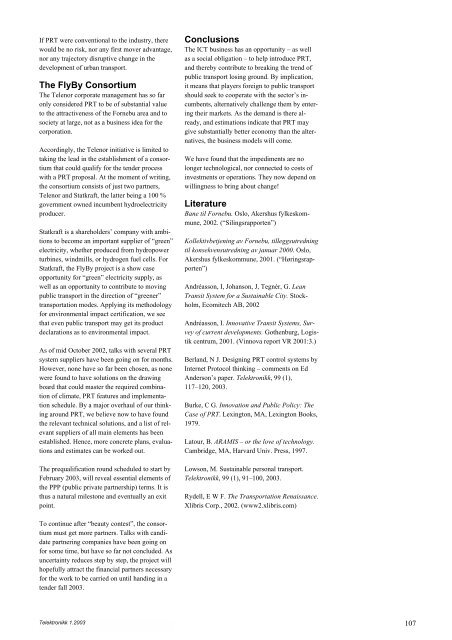Intelligent Transport Systems - Telenor
Intelligent Transport Systems - Telenor
Intelligent Transport Systems - Telenor
You also want an ePaper? Increase the reach of your titles
YUMPU automatically turns print PDFs into web optimized ePapers that Google loves.
If PRT were conventional to the industry, there<br />
would be no risk, nor any first mover advantage,<br />
nor any trajectory disruptive change in the<br />
development of urban transport.<br />
The FlyBy Consortium<br />
The <strong>Telenor</strong> corporate management has so far<br />
only considered PRT to be of substantial value<br />
to the attractiveness of the Fornebu area and to<br />
society at large, not as a business idea for the<br />
corporation.<br />
Accordingly, the <strong>Telenor</strong> initiative is limited to<br />
taking the lead in the establishment of a consortium<br />
that could qualify for the tender process<br />
with a PRT proposal. At the moment of writing,<br />
the consortium consists of just two partners,<br />
<strong>Telenor</strong> and Statkraft, the latter being a 100 %<br />
government owned incumbent hydroelectricity<br />
producer.<br />
Statkraft is a shareholders’ company with ambitions<br />
to become an important supplier of “green”<br />
electricity, whether produced from hydropower<br />
turbines, windmills, or hydrogen fuel cells. For<br />
Statkraft, the FlyBy project is a show case<br />
opportunity for “green” electricity supply, as<br />
well as an opportunity to contribute to moving<br />
public transport in the direction of “greener”<br />
transportation modes. Applying its methodology<br />
for environmental impact certification, we see<br />
that even public transport may get its product<br />
declarations as to environmental impact.<br />
As of mid October 2002, talks with several PRT<br />
system suppliers have been going on for months.<br />
However, none have so far been chosen, as none<br />
were found to have solutions on the drawing<br />
board that could master the required combination<br />
of climate, PRT features and implementation<br />
schedule. By a major overhaul of our thinking<br />
around PRT, we believe now to have found<br />
the relevant technical solutions, and a list of relevant<br />
suppliers of all main elements has been<br />
established. Hence, more concrete plans, evaluations<br />
and estimates can be worked out.<br />
The prequalification round scheduled to start by<br />
February 2003, will reveal essential elements of<br />
the PPP (public private partnership) terms. It is<br />
thus a natural milestone and eventually an exit<br />
point.<br />
To continue after “beauty contest”, the consortium<br />
must get more partners. Talks with candidate<br />
partnering companies have been going on<br />
for some time, but have so far not concluded. As<br />
uncertainty reduces step by step, the project will<br />
hopefully attract the financial partners necessary<br />
for the work to be carried on until handing in a<br />
tender fall 2003.<br />
Telektronikk 1.2003<br />
Conclusions<br />
The ICT business has an opportunity – as well<br />
as a social obligation – to help introduce PRT,<br />
and thereby contribute to breaking the trend of<br />
public transport losing ground. By implication,<br />
it means that players foreign to public transport<br />
should seek to cooperate with the sector’s incumbents,<br />
alternatively challenge them by entering<br />
their markets. As the demand is there already,<br />
and estimations indicate that PRT may<br />
give substantially better economy than the alternatives,<br />
the business models will come.<br />
We have found that the impediments are no<br />
longer technological, nor connected to costs of<br />
investments or operations. They now depend on<br />
willingness to bring about change!<br />
Literature<br />
Bane til Fornebu. Oslo, Akershus fylkeskommune,<br />
2002. (“Silingsrapporten”)<br />
Kollektivbetjening av Fornebu, tilleggsutredning<br />
til konsekvensutredning av januar 2000. Oslo,<br />
Akershus fylkeskommune, 2001. (“Høringsrapporten”)<br />
Andréasson, I, Johanson, J, Tegnér, G. Lean<br />
Transit System for a Sustainable City. Stockholm,<br />
Ecomitech AB, 2002<br />
Andréasson, I. Innovative Transit <strong>Systems</strong>, Survey<br />
of current developments. Gothenburg, Logistik<br />
centrum, 2001. (Vinnova report VR 2001:3.)<br />
Berland, N J. Designing PRT control systems by<br />
Internet Protocol thinking – comments on Ed<br />
Anderson’s paper. Telektronikk, 99 (1),<br />
117–120, 2003.<br />
Burke, C G. Innovation and Public Policy: The<br />
Case of PRT. Lexington, MA, Lexington Books,<br />
1979.<br />
Latour, B. ARAMIS – or the love of technology.<br />
Cambridge, MA, Harvard Univ. Press, 1997.<br />
Lowson, M. Sustainable personal transport.<br />
Telektronikk, 99 (1), 91–100, 2003.<br />
Rydell, E W F. The <strong>Transport</strong>ation Renaissance.<br />
Xlibris Corp., 2002. (www2.xlibris.com)<br />
107
















